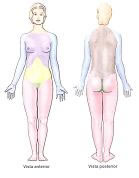Anatomical Approaches
The three main approaches to studying anatomy are: regional, systemic and clinical.
a) Regional Anatomy: is the method of studying the body by regions, such as the chest and abdomen. Surface anatomy is an essential part of the study of regional anatomy.
b) Systemic Anatomy: is the method of studying the body by systems, for example, the circulatory and reproductive systems.
c) Clinical Anatomy: emphasizes structure and function as they relate to the practice of medicine and other health sciences.

From a medical point of view, human anatomy consists of knowledge of the exact shape, exact position, size and relationship between the various structures of the human body, as characteristics related to health. This type of study is called descriptive or topographical anatomy. Topographic anatomy is learned through repeated exercises of dissection and inspection of parts (corpses especially intended for research).
From a morphological point of view, human anatomy is a scientific study that aims to discover the causes that led the structures of the human body to be as they are, and for that purpose helps the known sciences as embryology, evolutionary biology, phylogeny and histology.
In the medical field there is yet another type of anatomical study, defined as pathological anatomy, which is the study of defective organs or organs affected by diseases. The branches of normal anatomy with specific applications, or restricted to certain aspects, are given names such as medical anatomy, surgical anatomy, artistic anatomy, surface anatomy.
